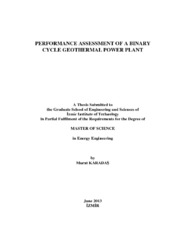Please use this identifier to cite or link to this item:
https://hdl.handle.net/11147/3608| Title: | Performance Assessment of a Binary Cycle Geothermal Power Plant | Authors: | Karadaş, Murat | Advisors: | Çelik, Hüseyin Murat | Keywords: | Multiple regression analysis Energy performance analysis |
Publisher: | Izmir Institute of Technology | Abstract: | An air cooled binary cycle GPP is thermodynamically modeled by using the design data of an actual plant. Effects of design parameters are investigated to plant performance. The modeling binary cycle power plant is produced 6514 kWe by using 542.65 ton/hour brine, 22.45 ton/hour steam and 33.4% NCGs content of steam at 157.9 °C geothermal resource temperature and 17.1 °C average ambient air conditions. The thermal efficiency of the model plant is found 11.32 %. The performance equations and the theoretical net power correction factors of the plant are created by using the thermodynamic model. According to this model, the net power generation of the plant increases with an increase in brine temperature, and mass flow rates of brine and steam; decreases with an increase of ambient air temperature and NCGs content of the steam. Furthermore, regression analysis of DORA-1 GPP is conducted using actual plant data to assess the plant performance. The annual multiple linear regression models are developed from 2006 to 2012 to estimate the performance of a geothermal power plant by using three measured dependent variables: the ambient air temperature, the brine flow rate and temperature. These models are tested by using classical assumptions of linear regressions, positive serial autocorrelation is found in all models. Autocorrelations are eliminated by using Orcutt-Cochran method. Although the performance model trends from 2006 to 2008 are found to be close, the performance status of the plant is generally variable from year to year. According to perennial regression models, the plant performance has started to decline with 270 kWe electricity generation capacity since 2009. The total degradation of the plant performance reached to 760 kWe capacity by 2012. Additionally, the statistical net power correction factors are calculated using regression model of 2008. Consequently, the net power correction factors for thermodynamic model and regression analysis are compared with DORA-1’s manufacturer, Ormat, correction factors. Although there are some minor differences, all of the net power correction factors have similar trends. The comparison shows that Ormat’s correction factors don’t exactly express the performance status of the DORA-1 GPP. | Description: | Thesis (Master)--Izmir Institute of Technology, Energy Engineering, Izmir, 2013 Includes bibliographical references (leaves: 97-99) Text in English; Abstract: Turkish and English xii, 75 leaves Full text release delayed at author's request until 2016.09.01 |
URI: | http://hdl.handle.net/11147/3608 |
| Appears in Collections: | Master Degree / Yüksek Lisans Tezleri |
Files in This Item:
| File | Description | Size | Format | |
|---|---|---|---|---|
| 10014345.pdf | MasterThesis | 4.03 MB | Adobe PDF |  View/Open |
CORE Recommender
Page view(s)
348
checked on Apr 14, 2025
Download(s)
440
checked on Apr 14, 2025
Google ScholarTM
Check
Items in GCRIS Repository are protected by copyright, with all rights reserved, unless otherwise indicated.